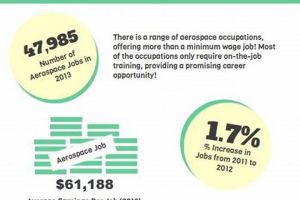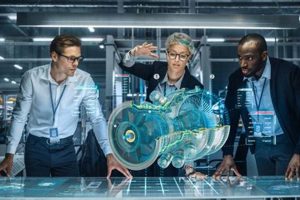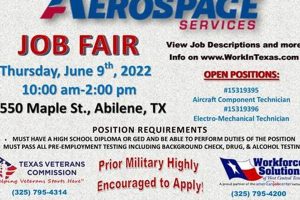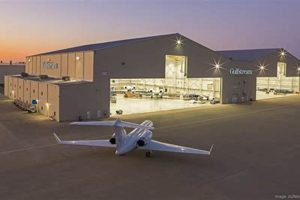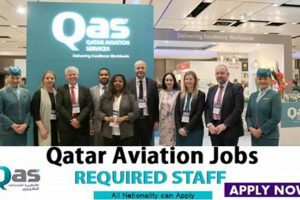The aerospace sector relies on skilled professionals to design, develop, and maintain aircraft, spacecraft, and related systems. The measure of the requirement for these specialists reflects a complex interplay of technological advancements, economic factors, and governmental policies. For instance, increased investment in space exploration programs often corresponds with a greater need for qualified individuals within the industry.
Understanding the projected requirements for professionals in this field is beneficial for several stakeholders. Prospective students can use this information to guide their educational and career choices. Educational institutions can adapt curricula to meet the evolving needs of the industry. Policymakers can leverage this data to inform workforce development initiatives and ensure national competitiveness. Historically, periods of heightened national security concerns and technological breakthroughs have led to surges in the requirement for expertise in this area.
The following sections will examine specific factors influencing the current and future outlook for professionals within the aerospace sector, analyzing trends in key sub-disciplines and geographic regions. This will also cover the impact of automation and artificial intelligence on the required skill sets, and discuss strategies for individuals seeking to enter or advance within this dynamic and critical industry.
The subsequent recommendations aim to provide actionable guidance for individuals seeking to successfully enter and advance within the aerospace engineering profession, given current and projected employment conditions.
Tip 1: Cultivate Specialized Expertise: The field requires continuous learning. Develop in-depth knowledge in a niche area such as composite materials, propulsion systems, or autonomous flight control. This targeted expertise significantly enhances marketability.
Tip 2: Acquire Advanced Degrees: Possession of a Master’s or Doctoral degree can be advantageous, particularly for research and development roles. Advanced studies demonstrate a commitment to intellectual rigor and in-depth understanding of complex concepts.
Tip 3: Pursue Relevant Certifications: Professional certifications, such as those offered by the American Institute of Aeronautics and Astronautics (AIAA), validate competency and provide a competitive edge in the recruitment process.
Tip 4: Secure Internships and Co-op Experiences: Practical experience gained through internships or cooperative education programs is highly valued by employers. These opportunities provide exposure to real-world challenges and foster valuable industry connections.
Tip 5: Develop Strong Communication Skills: Effective communication, both written and oral, is essential for collaborating within multidisciplinary teams and presenting technical information to diverse audiences.
Tip 6: Embrace Lifelong Learning: The aerospace industry is characterized by rapid technological advancements. Staying abreast of emerging trends through continuing education and professional development is crucial for long-term career success.
Tip 7: Target Growth Areas: Focus career development efforts on areas exhibiting high growth potential, such as unmanned aerial vehicles (UAVs), space tourism, and sustainable aviation technologies.
Implementing these strategies will position aspiring and current aerospace engineers for enhanced career prospects, enabling them to effectively navigate the complexities of the employment environment.
The concluding section will provide a synthesis of key insights and offer a final perspective on the future of the aerospace engineering profession.
1. Technological Advancements
Technological advancements serve as a primary driver influencing the requirements for aerospace engineers. These innovations reshape the skill sets demanded by the industry, creating new specializations and rendering others obsolete. A continuous assessment of these developments is essential for individuals and institutions seeking to align with the evolving employment landscape.
- Advanced Materials Development
The creation and implementation of novel materials, such as lightweight composites and high-temperature alloys, directly impacts design and manufacturing processes. This necessitates engineers with expertise in materials science, structural analysis, and advanced manufacturing techniques. For example, the increased use of carbon fiber reinforced polymers in aircraft construction requires engineers skilled in composite material design and repair, increasing requirements for such specialists.
- Autonomous Systems and Robotics
The integration of autonomous systems and robotics into aerospace applications, including unmanned aerial vehicles (UAVs) and robotic spacecraft, creates a demand for engineers proficient in artificial intelligence, machine learning, and control systems. The development of autonomous flight control systems and the automation of aircraft manufacturing processes both contribute to a growing need for specialists in these areas.
- Hypersonic Technology
Ongoing research and development in hypersonic flight systems, designed for speeds exceeding Mach 5, requires expertise in areas such as aerodynamics, propulsion, and thermal management. These advancements create the need for engineers with specialized knowledge in high-speed flow physics, scramjet engine design, and high-temperature materials. Government and private sector investment in hypersonic weapon systems and high-speed transportation technologies are key drivers.
- Sustainable Aviation Technologies
The increasing focus on environmental sustainability is driving innovation in aircraft design and propulsion systems. This includes the development of electric and hybrid-electric aircraft, as well as the implementation of sustainable aviation fuels. This emphasis creates a need for engineers with expertise in electric propulsion systems, battery technology, and alternative fuel sources.
These technological advancements, while diverse, all converge on a common point: they fundamentally alter the required expertise within the aerospace engineering profession. The demand for engineers with skills aligned to these emerging technologies is expected to continue growing, while the relevance of traditional skill sets may diminish. Therefore, continuous professional development and adaptation are crucial for individuals seeking to maintain a competitive edge in the aerospace engineering job market.
2. Economic Conditions
Economic conditions exert a substantial influence on the requirements for aerospace engineers. The fluctuations in economic cycles directly impact both commercial and governmental investment in the aerospace sector. Economic growth often leads to increased air travel and demand for new aircraft, translating to a greater need for design, manufacturing, and maintenance engineers. Conversely, economic recessions can trigger reductions in airline orders and defense spending, resulting in workforce reductions. The correlation is evident in the cyclical nature of employment within major aerospace companies, which often mirrors broader economic trends.
Furthermore, specific economic indicators, such as gross domestic product (GDP) growth and interest rates, can serve as predictors of the aerospace industry’s trajectory. Higher GDP growth typically correlates with increased consumer spending and business investment, driving demand for air travel and cargo transport, thus increasing aerospace manufacturing activities. Lower interest rates facilitate capital investment in aerospace projects, such as new aircraft development or expansion of space programs. The 2008 financial crisis provides a stark example: the ensuing economic downturn led to a significant decline in air travel and a subsequent reduction in aircraft orders, which resulted in widespread layoffs within the aerospace engineering workforce. These examples illustrate how carefully studying economic indicators offers an essential tool for forecasting employment patterns in the aerospace domain.
In summary, economic conditions represent a critical component influencing the volume and nature of aerospace engineering jobs. Monitoring key economic indicators and understanding their historical impact on the industry allows for a more informed assessment of future employment prospects. While technological advancements and government policies also play significant roles, the underlying economic climate establishes the foundation upon which these other factors operate. Recognizing this interplay is essential for both individual career planning and strategic workforce development initiatives within the aerospace sector.
3. Government Policies
Governmental regulations, funding initiatives, and international agreements wield considerable influence over the employment prospects for aerospace engineers. These policies shape the direction of the industry, impacting investment in research and development, defense spending, and space exploration, all of which directly affect the volume and type of positions available.
- Defense Spending and Procurement
Government investment in national defense constitutes a significant portion of the aerospace sector’s financial resources. Decisions regarding military aircraft procurement, missile defense systems, and related technologies have a direct and immediate effect. Increased defense spending typically translates to a greater need for engineers specializing in military aircraft design, avionics, and weapons systems. Conversely, budget cuts or shifts in defense priorities can lead to reductions in these specific areas. For example, the development of a new fighter jet program would create thousands of engineering jobs, while the cancellation of such a program would result in significant layoffs.
- Space Exploration Programs
Government-funded space agencies, such as NASA, drive demand for aerospace engineers through their ambitious exploration programs. Initiatives like lunar missions, Mars exploration, and the development of new spacecraft require a diverse range of expertise, including propulsion systems, robotics, and life support. Increased investment in space exploration generates opportunities for engineers specializing in these domains, while reductions in funding can limit the scope of these programs and, consequently, the requirement for specialized personnel. The Space Launch System (SLS) program, for instance, has sustained a large engineering workforce for over a decade.
- Export Controls and International Trade Agreements
Government policies regulating the export of aerospace technologies and participation in international trade agreements can significantly impact the industry’s competitiveness and global market access. Restrictions on the export of sensitive technologies may limit the growth potential of certain sectors, while favorable trade agreements can open up new markets and increase demand for aerospace products and services. The International Traffic in Arms Regulations (ITAR) in the United States, for example, impose strict controls on the export of defense-related technologies, which can affect the ability of U.S. companies to compete in certain international markets.
- Environmental Regulations and Sustainability Initiatives
Growing concerns about climate change and environmental sustainability are driving the implementation of new regulations and incentives aimed at reducing the environmental impact of aviation. These policies are prompting the development of more fuel-efficient aircraft, alternative propulsion systems, and sustainable aviation fuels. This shift is creating demand for engineers with expertise in areas such as electric propulsion, biofuels, and advanced materials, while potentially diminishing the requirement for engineers focused solely on traditional combustion engine technologies. Government support for research and development in sustainable aviation technologies is a key driver of this trend.
The interplay of these governmental policies underscores the necessity for aerospace engineers and relevant organizations to remain informed about evolving political and regulatory landscapes. Proactive adaptation to these policy shifts is essential for navigating the employment environment and capitalizing on emerging opportunities. Understanding the priorities and long-term goals of governmental bodies provides a crucial advantage in anticipating industry trends and ensuring alignment with future workforce needs.
4. Defense Spending
Defense spending serves as a significant catalyst for employment opportunities within the aerospace engineering sector. A direct correlation exists between governmental investment in military programs and the volume of available positions for engineers specializing in related fields. Increased budgetary allocations for defense initiatives, such as the development of advanced aircraft, missile systems, and surveillance technologies, invariably lead to heightened requirement for qualified aerospace engineers to design, develop, test, and maintain these complex systems.
The practical significance of understanding this connection lies in its ability to inform workforce planning and career trajectory. During periods of increased defense spending, aerospace companies actively recruit engineers with expertise in areas such as aerodynamics, propulsion, avionics, and materials science. Conversely, reductions in defense budgets can result in workforce reductions, particularly in sectors heavily reliant on government contracts. A historical example of this dynamic is the post-Cold War drawdown of the 1990s, which led to significant consolidation and job losses within the aerospace industry as defense budgets were curtailed. More recently, increased global tensions and renewed focus on military modernization have spurred increased defense spending in many countries, resulting in a corresponding rise in opportunities for aerospace engineers.
In conclusion, defense spending constitutes a crucial component influencing the employment landscape for aerospace engineers. Monitoring trends in defense budgets and understanding their implications for specific engineering disciplines is essential for individuals seeking to enter or advance within this field. Furthermore, educational institutions and workforce development programs must adapt their curricula to align with the evolving needs of the defense sector to ensure a skilled and competitive workforce capable of meeting future demands. Failure to acknowledge this connection can lead to misinformed career decisions and a potential skills gap within the industry.
5. Commercial Aviation
Commercial aviation exerts a significant influence on the employment requirements for aerospace engineers. The demand for new aircraft, driven by passenger traffic growth and airline fleet renewal strategies, directly translates into engineering opportunities across design, manufacturing, and maintenance sectors. Increases in air travel necessitate the development of more fuel-efficient, quieter, and safer aircraft, stimulating innovation and research. Consequently, aerospace companies actively seek engineers with expertise in aerodynamics, propulsion systems, structural analysis, and avionics to meet the demands of this dynamic market. For example, the sustained growth of low-cost carriers in Asia has spurred demand for narrow-body aircraft, leading to increased production rates at manufacturers like Airbus and Boeing, and therefore, an elevated requirement for engineers across their supply chains.
Furthermore, the aging of existing aircraft fleets necessitates ongoing maintenance, repair, and overhaul (MRO) activities, generating a consistent requirement for aerospace engineers with skills in structural integrity, non-destructive testing, and maintenance planning. Regulatory compliance and safety standards, mandated by agencies such as the Federal Aviation Administration (FAA) and the European Union Aviation Safety Agency (EASA), further contribute to the demand for engineers involved in ensuring airworthiness and operational safety. The development of new technologies aimed at improving air traffic management and reducing congestion, such as satellite-based navigation systems, also creates opportunities for engineers specializing in communications, navigation, and surveillance (CNS) systems. The economic viability of airlines and their ability to invest in new aircraft and technologies are directly linked to broader economic conditions, thus creating a cyclical pattern in the requirement for aerospace engineering expertise.
In conclusion, commercial aviation remains a critical component influencing employment for aerospace engineers. The industry’s continuous pursuit of efficiency, safety, and sustainability drives innovation and sustains the requirement for skilled professionals. Understanding the intricate relationship between commercial aviation trends, technological advancements, and regulatory requirements is essential for individuals pursuing careers in this dynamic field. While subject to economic fluctuations, the long-term growth prospects of air travel and the ongoing need to maintain and upgrade existing fleets ensure a persistent, albeit variable, demand for qualified aerospace engineers.
6. Space Exploration
Space exploration initiatives serve as a significant catalyst for the requirement for aerospace engineers. These endeavors, ranging from robotic missions to crewed expeditions, necessitate a diverse array of engineering expertise, thereby creating a substantial and specialized labor market.
- Robotics and Automation
Space exploration relies heavily on robotic systems for remote exploration, sample collection, and in-situ resource utilization. Designing, building, and operating these robots requires engineers with expertise in mechanical engineering, electrical engineering, computer science, and robotics. Missions like the Mars rovers Curiosity and Perseverance exemplify this, as their success hinges on the expertise of engineers who can create autonomous systems capable of operating in harsh, remote environments. The continued reliance on robotic systems in space exploration ensures a persistent requirement for professionals with these specialized skills.
- Propulsion Systems
Reaching and traversing space demands advanced propulsion systems. Aerospace engineers specializing in propulsion design and development are crucial for creating efficient and reliable engines for rockets, spacecraft, and satellites. From chemical rockets to electric propulsion, the field requires constant innovation to reduce travel times and increase payload capacity. NASA’s development of the Space Launch System (SLS) is a prime example, requiring a substantial workforce of propulsion engineers. Advances in propulsion technology directly expand the feasibility and scope of space exploration, driving the need for engineers in this domain.
- Life Support Systems
Crewed space missions necessitate the development and implementation of life support systems that provide breathable air, potable water, food, and waste management. Aerospace engineers with expertise in biomedical engineering, environmental control, and human factors are essential for designing these systems, ensuring the health and safety of astronauts during long-duration missions. The International Space Station (ISS) relies on complex life support systems, continually maintained and upgraded by a team of engineers. As crewed missions venture further into space and for longer durations, the demand for life support expertise will intensify.
- Materials Science and Engineering
The extreme conditions of space, including radiation, vacuum, and extreme temperatures, necessitate the use of specialized materials. Aerospace engineers with expertise in materials science and engineering play a crucial role in developing and testing materials that can withstand these challenges. Developing radiation-shielded spacecraft and lightweight, high-strength structures requires a deep understanding of material properties and manufacturing processes. The use of advanced composites in spacecraft construction is an example of this, requiring engineers skilled in composite materials and their application in space structures. The ongoing search for durable, high-performance materials ensures a continuous requirement for materials engineers in the space exploration sector.
These facets highlight the integral role of aerospace engineers in facilitating space exploration. The continued investment in and expansion of space exploration initiatives guarantees sustained requirement for professionals with specialized skills in robotics, propulsion, life support, and materials science. The pursuit of new frontiers in space depends on the expertise and innovation of aerospace engineers, ensuring that the sector remains a vibrant and crucial component of the global economy.
Frequently Asked Questions
The following questions and answers address common inquiries concerning employment prospects for aerospace engineers. The information is intended to provide clarity and insight into the factors influencing workforce needs within the sector.
Question 1: What factors contribute most significantly to fluctuations in the requirement for aerospace engineers?
Defense spending, commercial aviation growth, and governmental investment in space exploration are primary drivers. Economic conditions indirectly influence these factors, impacting airline profitability and government budgetary allocations.
Question 2: Are specific specializations within aerospace engineering experiencing higher or lower demand?
Specializations related to autonomous systems, sustainable aviation technologies, and advanced materials generally exhibit higher demand due to ongoing technological advancements and environmental concerns. Positions focused solely on legacy systems may experience reduced demand.
Question 3: How does the globalization of the aerospace industry affect domestic employment opportunities?
Globalization creates both opportunities and challenges. While international collaborations can lead to technology transfer and expanded markets, increased competition from foreign companies may affect domestic job availability.
Question 4: What role do advanced degrees play in securing employment as an aerospace engineer?
Advanced degrees, particularly at the Master’s or Doctoral level, are often advantageous for research and development positions. They demonstrate a deeper understanding of complex concepts and a commitment to intellectual rigor.
Question 5: What strategies can aspiring aerospace engineers employ to enhance their employability?
Cultivating specialized expertise in high-demand areas, acquiring relevant certifications, securing internships, and developing strong communication skills are all effective strategies.
Question 6: How is automation and artificial intelligence (AI) impacting the aerospace engineering profession?
Automation and AI are transforming various aspects of aerospace engineering, from design and manufacturing to maintenance and operations. Engineers with skills in these areas are increasingly sought after, while some traditional roles may become automated.
In summary, employment opportunities for aerospace engineers are influenced by a complex interplay of factors, including technological advancements, economic conditions, governmental policies, and global competition. Proactive adaptation and continuous professional development are crucial for navigating this dynamic landscape.
The subsequent section will explore the regional variations in the job market for aerospace engineers, examining areas with high growth potential and specific skill requirements.
Job Demand for Aerospace Engineers
The preceding analysis has examined the multifaceted factors influencing job demand for aerospace engineers. Technological advancements, economic conditions, governmental policies, defense spending, commercial aviation, and space exploration each contribute significantly to the fluctuating need for skilled professionals within the industry. Recognizing the interconnectedness of these elements is crucial for both individuals pursuing careers in aerospace and for organizations engaged in workforce planning.
The dynamic nature of the aerospace sector necessitates continuous adaptation and a proactive approach to skill development. Monitoring industry trends, embracing emerging technologies, and acquiring relevant certifications will be paramount for securing future opportunities. The aerospace field remains a vital component of global innovation and economic growth; therefore, ongoing investment in education, research, and development is essential for maintaining a competitive and capable aerospace engineering workforce.


